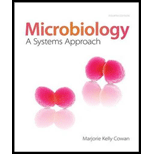
Microbiology: A Systems Approach
4th Edition
ISBN: 9780073402437
Author: Marjorie Kelly Cowan Professor
Publisher: McGraw-Hill Education
expand_more
expand_more
format_list_bulleted
Concept explainers
Question
Chapter 22, Problem 1CM
Summary Introduction
To create: The concept map by using the terms given in the question.
Introduction:
Toxicity is defined as the degree to which a substance is harmful to humans or animals. Microbial toxins are defined as a type of toxin which is produced by microorganisms including bacteria and
Expert Solution & Answer
Want to see the full answer?
Check out a sample textbook solution
Students have asked these similar questions
Please help me calculate drug dosage from the following information:
Patient weight: 35 pounds, so 15.9 kilograms (got this by dividing 35 pounds by 2.2 kilograms)
Drug dose: 0.05mg/kg
Drug concentration: 2mg/mL
A 25-year-old woman presents to the emergency department with a 2-day history of fever, chills, severe headache, and confusion. She recently returned from a trip to sub-Saharan Africa, where she did not take malaria prophylaxis. On examination, she is febrile (39.8°C/103.6°F) and hypotensive. Laboratory studies reveal hemoglobin of 8.0 g/dL, platelet count of 50,000/μL, and evidence of hemoglobinuria. A peripheral blood smear shows ring forms and banana-shaped gametocytes. Which of the following Plasmodium species is most likely responsible for her severe symptoms?
A.
Plasmodium vivax
B.
Plasmodium ovale
C.
Plasmodium malariae
D.
Plasmodium falciparum
Standard Concentration (caffeine) mg/L
Absorbance Reading
10
0.322
20
0.697
40
1.535
60
2.520
80
3.100
Chapter 22 Solutions
Microbiology: A Systems Approach
Ch. 22.1 - Prob. 1AYPCh. 22.1 - Prob. 2AYPCh. 22.2 - Prob. 3AYPCh. 22.2 - Prob. 4AYPCh. 22.3 - Prob. 2CFCh. 22.3 - List the possible causative agents for the...Ch. 22.3 - Prob. 6AYPCh. 22.3 - Name one distinct feature for each of the acute...Ch. 22.3 - Prob. 8AYPCh. 22.3 - Prob. 9AYP
Ch. 22.3 - Differentiate among the main types of hepatitis...Ch. 22.4 - Prob. 11AYPCh. 22.4 - Prob. 12AYPCh. 22.4 - Prob. 13AYPCh. 22.4 - Prob. 14AYPCh. 22.4 - Describe the type of disease caused by Trichinella...Ch. 22.4 - Prob. 16AYPCh. 22 - Prob. 1CFCh. 22 - Food moves down the GI tract through the action of...Ch. 22 - Prob. 2MCQCh. 22 - Gastric ulcers are caused by a. Treponema...Ch. 22 - Prob. 4MCQCh. 22 - Prob. 5MCQCh. 22 - Prob. 6MCQCh. 22 - This microorganism is commonly associated with...Ch. 22 - Prob. 8MCQCh. 22 - Prob. 9MCQCh. 22 - Prob. 10MCQCh. 22 - Prob. 11TFCh. 22 - Giardia lamblia is a water-borne, flagellated...Ch. 22 - Prob. 13TFCh. 22 - Prob. 14TFCh. 22 - Enterobius vermicularis commonly known as the...Ch. 22 - Prob. 1CTQCh. 22 - Prob. 2CTQCh. 22 - Prob. 3CTQCh. 22 - Prob. 4CTQCh. 22 - Prob. 5CTQCh. 22 - Prob. 6CTQCh. 22 - Prob. 7CTQCh. 22 - a. Describe methods used to definitively diagnose...Ch. 22 - Prob. 9CTQCh. 22 - Prob. 10CTQCh. 22 - Prob. 1CCCh. 22 - Prob. 2CCCh. 22 - Prob. 3CCCh. 22 - Prob. 4CCCh. 22 - Prob. 5CCCh. 22 - Prob. 6CCCh. 22 - Prob. 7CCCh. 22 - Prob. 8CCCh. 22 - Prob. 1VCCh. 22 - Prob. 2VCCh. 22 - Prob. 1CM
Knowledge Booster
Learn more about
Need a deep-dive on the concept behind this application? Look no further. Learn more about this topic, biology and related others by exploring similar questions and additional content below.Similar questions
- please draw in the answers, thank youarrow_forwarda. On this first grid, assume that the DNA and RNA templates are read left to right. DNA DNA mRNA codon tRNA anticodon polypeptide _strand strand C с A T G A U G C A TRP b. Now do this AGAIN assuming that the DNA and RNA templates are read right to left. DNA DNA strand strand C mRNA codon tRNA anticodon polypeptide 0 A T G A U G с A TRParrow_forwardplease answer all question below with the following answer choice, thank you!arrow_forward
- please draw in the answeres, thank youarrow_forwardA) What is being shown here?B) What is indicated by the RED arrow?C) What is indicated by the BLUE arrow?arrow_forwardPlease identify the curve shown below. What does this curve represent? Please identify A, B, C, D, and E (the orange oval). What is occurring in these regions?arrow_forward
- Please identify the test shown here. 1) What is the test? 2) What does the test indicate? How is it performed? What is CX? 3) Why might the test be performed in a clinical setting? GEN CZ CX CPZ PTZ CACarrow_forwardDetermine how much ATP would a cell produce when using fermentation of a 50 mM glucose solution?arrow_forwardDetermine how much ATP would a cell produce when using aerobic respiration of a 7 mM glucose solution?arrow_forward
arrow_back_ios
SEE MORE QUESTIONS
arrow_forward_ios
Recommended textbooks for you
 Medical Terminology for Health Professions, Spira...Health & NutritionISBN:9781305634350Author:Ann Ehrlich, Carol L. Schroeder, Laura Ehrlich, Katrina A. SchroederPublisher:Cengage Learning
Medical Terminology for Health Professions, Spira...Health & NutritionISBN:9781305634350Author:Ann Ehrlich, Carol L. Schroeder, Laura Ehrlich, Katrina A. SchroederPublisher:Cengage Learning Human Heredity: Principles and Issues (MindTap Co...BiologyISBN:9781305251052Author:Michael CummingsPublisher:Cengage Learning
Human Heredity: Principles and Issues (MindTap Co...BiologyISBN:9781305251052Author:Michael CummingsPublisher:Cengage Learning Comprehensive Medical Assisting: Administrative a...NursingISBN:9781305964792Author:Wilburta Q. Lindh, Carol D. Tamparo, Barbara M. Dahl, Julie Morris, Cindy CorreaPublisher:Cengage Learning
Comprehensive Medical Assisting: Administrative a...NursingISBN:9781305964792Author:Wilburta Q. Lindh, Carol D. Tamparo, Barbara M. Dahl, Julie Morris, Cindy CorreaPublisher:Cengage Learning

Medical Terminology for Health Professions, Spira...
Health & Nutrition
ISBN:9781305634350
Author:Ann Ehrlich, Carol L. Schroeder, Laura Ehrlich, Katrina A. Schroeder
Publisher:Cengage Learning


Human Heredity: Principles and Issues (MindTap Co...
Biology
ISBN:9781305251052
Author:Michael Cummings
Publisher:Cengage Learning



Comprehensive Medical Assisting: Administrative a...
Nursing
ISBN:9781305964792
Author:Wilburta Q. Lindh, Carol D. Tamparo, Barbara M. Dahl, Julie Morris, Cindy Correa
Publisher:Cengage Learning